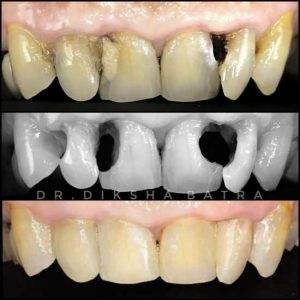They say “Bache aur boodhe ek jaise
”So just like a pediatric dentist and a pediatric dental visit are specialised for children, a geriatric dental visit is not a routine dental procedure and should be treated differently from a regular adult appointment. Most of us pack in a 75-year-old case as part of our routine daily schedule not realising that they may need special attention in several aspects of their treatment. Let’s explore some common aspects that can be considered before caring for senior citizens.

Detailed medical history
An old person may not even look old and sometimes may convince you of how healthy they are and how they just got a blood test and everything was fine. Most people undermine the seriousness of a dental appointment by innocently assuming what does this have to do with my health. Sometimes it’s not remembering or just failing to mention important medications, allergies or procedures. So it becomes imperative to ensure that we are making doubly sure by asking them leading questions and extracting the useful medical history to ensure nothing endangers them. In case of any doubts, it’s best to order tests again just to be doubly sure.

Treatment objectives
We hardly ever notice the subtle changes in the treatment plan and diagnosis that are needed when planning a geriatric case. Anaesthetic filling in a 20-year-old will be much more high on esthetic perfection and can be done with a rubber dam and anaesthesia with additional cosmetic procedures. Most often we may not have the same luxury with a geriatric case. In this case, just ensuring decay removal without making the patient gag in the shortest duration is the objective of treatment. Similarly, when planning full mouth implants or even long span bridge replacements there are numerous factors to consider right from the longevity of both patient and prosthesis, to cost, to other medical diseases, oral hygiene and general decay rate. It would be a good practice to establish the treatment objective right at the start, it could be pain relief, tooth replacement, caries control. Whichever it may function will always precede esthetic demand in these cases.

Cost vs benefit
With all the elderly patients that we treat even the ones who are extremely affording the general perception is to try and be conservative on the cost to benefit ratio. A large majority would rather let the issue be as opposed to spending a large sum for a time that they may not even live for- depending on the age. The popular dental joke is “my bridge or implant may outlast me. ”We must remain mindful of our patient’s desires and ensure we give them some out of the box and yet cost competent solutions in the waning years of life

Shorter & fewer appointments
Most elderly patients may have mobility issues and for those who are agile, they may still have a host of other medical problems, least of them being weak back and neck muscles. Prolonged dental sessions can strain them so best to keep their appointments in the morning after their medications and just before lunch so as their meal times don’t get affected. The aim should be to go in with a well thought out treatment plan that minimizes visits and maximizes outcome.
Caring for the elderly deserves due consideration and it becomes our moral and professional responsibility to look after these patients with a prepared and methodical approach even if that involves roping in specialists to ensure a better experience.

